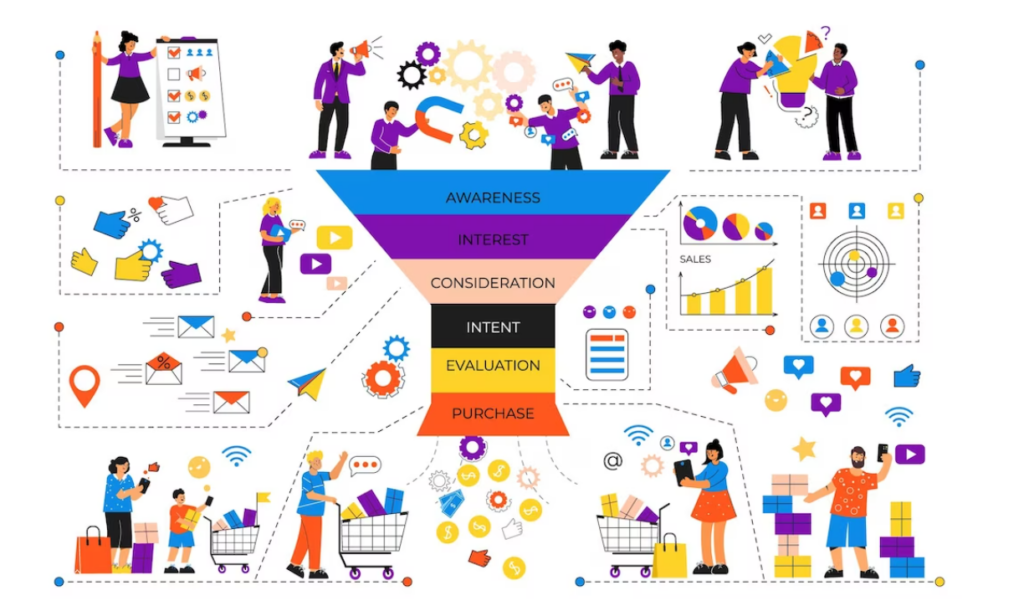When creating your B2B inbound marketing plan, the primary focus is often on attracting and capturing leads for your sales pipeline. However, it’s crucial to evaluate the quality of these prospects and their likelihood of converting. It’s essential to understand if the leads are just browsing for the best deal, genuinely interested in your products, or ready to make a purchase.
To target leads efficiently at each stage of the sales funnel, a qualification strategy is necessary. One effective approach is to establish a lead-scoring process that identifies leads primed for conversion and those that require further engagement from your sales team. So, what is scoring, and how can it improve your bottom line? In the following sections, we’ll discuss the concept of lead scoring and explore some best practices that can enhance the effectiveness of your qualification efforts.
Maximizing Sales Potential with Lead Scoring
Lead scoring is a powerful technique used to evaluate the quality of prospects and generate more business. Not all potential customers who interact with your brand are equal. Each prospect possesses unique challenges, needs, and aspirations that influence their future purchasing decisions. With scoring, you can assess your leads based on various attributes:
- Implicit data: Information you already possess about the lead;
- Explicit data: Factual information confirmed by the lead through forms or phone calls;
- Behavior data: Data derived from the actions the lead has taken, such as form submissions or whitepaper downloads;
- Demographic data: Includes details like company size, industry, geographic location, and more.
By implementing a lead scoring process, your marketing and sales teams can become more efficient by prioritizing prospects for targeted engagement. As a result, you have the potential to boost conversion rates and accelerate deal closures.
Predictive Lead Scoring
Automation is vital for success, as recognized by 91% of marketers. While lead scoring models enhance productivity and conversions, they require testing and feedback to align with your business requirements. Manual effort is typically involved in lead scoring, demanding continuous updates for accuracy and desired outcomes.
Nevertheless, if you prefer a “set-it-and-forget-it” approach, predictive lead scoring offers an ideal solution. By leveraging machine learning and data points, it identifies the most promising customers, eliminating manual tasks. Predictive lead scoring analyzes commonalities among your customers and recycled accounts, creating a prioritization formula. This empowers your sales team to concentrate on prospects nearer to the point of purchase.

Lead Scoring’s Role in Sales and Marketing Alignment
To close deals and speed up the sales cycle, it’s critical to deliver the right message to prospects at the right time. While lead scoring can provide precision to your team, it can also be a time-intensive process.
It’s important to keep in mind that engagement with your content doesn’t necessarily indicate the buyer’s intent. For instance, someone visiting your pricing page and downloading a whitepaper may just be researching your company or seeking a new job.
To engage with your target audience effectively, you may need to shift your strategy beyond traditional lead-scoring methods to channels where they hang out, such as Slack, podcasts, and direct messages.
Focus on providing valuable education to prospects who haven’t yet entered the buying stage, so they are warmed up to your brand and ready to convert when they do. Instead of aligning performance metrics on MQLs and TOFU, you can measure success by the number of meetings held or closed revenue. This way, your sales team can focus on leads more likely to convert based on intent signals rather than inflated user actions on your website.
This doesn’t mean that lead scoring is an ineffective method to evaluate prospects. However, it highlights the need to keep up with evolving customer behavior and engage with prospects on the platforms where they are most active.
Various Approaches to Lead Scoring
Lead scoring models are used to assign values to each prospect based on their compatibility with your product and likelihood to convert. While many scoring systems have a point range of up to 100, each model supports a specific attribute that you assign to your customers. Here are a few different models you can develop based on customer data:
- Demographic and Company Data: Create a model based on attributes like location, age, gender, industry, company size, and annual revenue to exclude any outliers. For example, if you only sell products to certain locations, anyone who submits information outside of that zip code, state, or country would be assigned a negative score to ensure your sales team doesn’t focus on them;
- Email and Social Engagement: Pay close attention to your open and click-through rates and provide that data to your sales team. Assign a higher point value to someone who opens and clicks on a demo email than to a contact who only opened a newsletter. Similarly, assign a higher score to a prospect who engages with your content on social media, such as liking or sharing it;
- Website User Behavior: Assess the prospect’s website activity by determining whether they downloaded any materials, how many pages they visited, how long they stayed on each page, whether they visited high-value pages like a pricing or demo page, and whether they filled out a form. Assign points to better categorize their sales funnel stage;
- Detect Spam Contacts: Score any spam individuals negatively so your sales team doesn’t waste resources trying to reach out to them.
By using different lead scoring models, you can better evaluate your prospects and focus your sales efforts on those more likely to convert.
Four Steps to Scoring Your Leads

Calculating a lead score can be confusing with so many different attributes and models to choose from. If you’re not ready to invest in a predictive lead scoring tool yet, you can still develop a manual calculation to empower cross-functional teams. Here are four steps to get started:
| Steps | Description |
|---|---|
| Calculate the Conversion Rate for All Leads | Use the lead-to-customer conversion rate as your baseline for the lead scoring calculation. For example, if you acquire 50 customers out of 350 leads, your conversion rate is 14%. |
| Build Attributes from High-Quality Converted Customers | Develop attributes based on your current customers’ behavior or demographics. Select your attributes based on customer data, analytics, or who your sales team believes is the ideal target audience. |
| Calculate the Scoring for Each Attribute | Determine how many qualified leads become customers based on their demographics or behavior. Rank these values by analyzing your website and marketing metrics or run an attribution report to determine how these actions affect the sales funnel. |
| Compare Values and Assign Points | Compare the values to your actual conversion rates. If you notice certain attributes have higher rates than your baseline, include those characteristics in your lead scoring formula. Assign points to each attribute or action to ensure your values reflect the actual lead quality. Continuously analyze your formula over time. |
By following these four steps, you can develop a manual lead scoring calculation to help you evaluate your leads and focus your sales efforts on those more likely to convert.
Lead Scoring Best Practices
As you embark on the journey of calculating lead scores and fine-tuning your formula, it’s important to tailor your approach to your company’s specific needs. While the combinations of scoring criteria will be unique to your business, optimizing the effectiveness of your system should be a top priority. To help you make the most of your lead scoring endeavors, here are four indispensable best practices:
| Lead Scoring Strategies | Description |
|---|---|
| Incorporate Negative Scoring | Introduce negative scores in your system to avoid inflating lead scores. For example, assign negative scores to leads who have been inactive for a certain period. |
| Use Different Scoring Models | Set up distinct scoring systems for each product line to accurately assess leads based on their specific interests and characteristics. |
| Create Threshold Alerts | Establish lead scoring threshold alerts, such as 60/100 points, to notify the sales team when a lead qualifies for personalized attention and follow-up. |
| Foster Sales and Marketing Alignment | Facilitate effective communication and collaboration between the sales and marketing teams to ensure a unified approach and drive successful lead conversions. |
| Gather Feedback from Customers | Engage with customers to understand their decision-making process and factors that influenced their choice to purchase from your business. |
| Seek Input from Sales Team | Consult the sales team to gain insights into the drivers of successful conversions and gather feedback on lead scoring effectiveness. |
Conclusion
Implementing lead scoring can yield impressive results by evaluating lead quality and optimizing resource allocation. This process not only saves time, money, and resources but also enhances alignment between marketing and sales teams. By accurately targeting leads with tailored messages, conversions can be accelerated. Although optimizing the lead scoring formula may require initial effort, the long-term benefits can significantly impact your bottom line and foster sustainable business growth.
